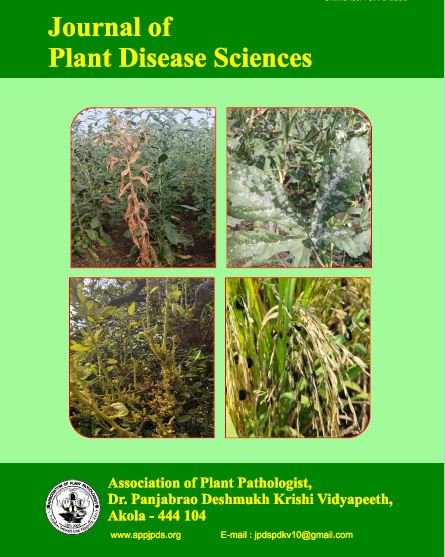ISOLATION, IDENTIFICATION, AND MANAGEMENT OF IN VITRO PHYTOPHTHORA NICOTIANAE, THE CAUSATIVE AGENT OF CITRUS GUMMOSIS
DOI:
https://doi.org/10.48165/jpds.2024.19.02.03Keywords:
Phytophthora nicotianae, Isolation, Fungicide, InhibitionAbstract
Various Phytophthora species have long been reported to cause different citrus diseases, including gummosis, root rot, fruit brown rot, and citrus decline worldwide, including in India. Among these, Phytophthora nicotianae has gained considerable attention due to its ability to cause citrus gummosis, leading to significant yield losses (approximately 10-30%).Considering this, the present study aimed to isolate the pathogen from infected plants, identify it based on morphological and microscopic characteristics, and evaluate its management using novel in vitro fungicides. The pathogen was isolated from gummosis-infected soil samples using the leaf bait method and exhibited cottony dense mycelium and aseptate hyphae as key morphological characteristics. Fungicide tests revealed 100% inhibition of P. nicotianae at a 2500 ppm concentration under laboratory conditions.References
Bowman, K.D., Albrecht, Graham and U. J.H. D.B. (36(1)): 44-49.
Bright, D. (2007). Detection of Phytophthora nicotianae and P. palmivora in citrus roots using PCR-RFLP in comparison with other methods. European Journal of Plant Pathology, 119: 143-158.
Das, A.K., Nerkar, Kumar, and Bawage, (2016). Detection, identification and characterization of Phytophthora spp. infecting citrus in India. Journal of Plant Pathology, 55-69.
Erwin, D.C. and Ribeiro, O.K. (1996). Phytophthora diseases worldwide. American Phytopathological Society (APS Press).
Feichtenberger, E. (2001). Doenças causadas por Phytophthora em citros. Livraria Rural Campinas, 283-342.
Graham, J.H. and Menge, J.A. (1999). Root diseases. In: Citrus Health Management, APS Press, pp. 126-135.
Graham, J.H. and Menge, J.A. (2000). Phytophthora-induced diseases. In: Compendium of Citrus Diseases, APS Press, St. Paul, MN, pp. 12-15.
Ho, H.H. (2018). The taxonomy and biology of Phytophthora and Pythium. J. Bacteriol. Mycol., 6: 40-45.
Jayalakshmi, K., Raju, J.H. and Ravindra, (2017). Root rot of apricot and cherry caused by Phytophthora palmivora. Plant Protection Science, 53(4): 216-225.
Mendonça, L.B.P., Coelho, J.B., Stracieri, Ferreira, L.J., Junior, N.D., and Tebaldi, (2015). Chemical control of Phytophthora wilt in tomatoes. Bioscience Journal, 31(4): 1015-1023.
Mounde, L.G., Ateka, E.M., Kihurani, A.W. and Wasilwa, L. (2012). Morphological characterization and identification of Phytophthora species causing citrus gummosis in Kenya. African Journal of Food, Agriculture, Nutrition and Development, 12(7). DOI: 10.18697/ajfand.55.11605.
Savita, G.S.V. and Nagpal, A. (2012). Citrus diseases caused by Phytophthora species. GERF Bulletin of Biosciences, 3(1): 18-27.
Thakre, B., Soni, U.C.L., and Gour, S.A.S. (2017). Use of suitable fungicides for the control of gummosis caused by Phytophthora sp. on Nagpur Mandarin in Satpura Plateau of Madhya Pradesh, India. International Journal of Current Microbiology and Applied Sciences, 6(7): 2395-2400.
Thomidis, T. and Tsipouridis, S. (2001). Effectiveness of metalaxyl, fosetyl-Al, dimethomorph, and cymoxanil against Phytophthora cactorum and P. citrophthora. Phytopathologia Mediterranea, 40(3): 253-259.
Turkolmez, S. and Dervis, S. (2017). Activity of metalaxyl-M plus mancozeb, fosetyl-Al, and phosphorous acid against crown Phytophthora species. Microbial Pathogenesis, 175: 105986.
Van Tran, Q., Ha, C.V., Vvedensky, V.V., Le, T.T.L., and Han, V.C. (2023). Pathogenicity and fungicide sensitivity of Phytophthora parvispora causing black shank disease in FCV tobacco both in vitro and in vivo. International Journal of Current Microbiology and Applied Sciences, 6(7): 2440-2446.
Verniere, C., Cohen, S., Raffanel, A.P., Dubois, B., Venard, F., and Panabieres, S. (2004). Variability in pathogenicity among Phytophthora spp. isolated from citrus in Corsica. Journal of Phytopathology, 152(8-9): 476-483.

